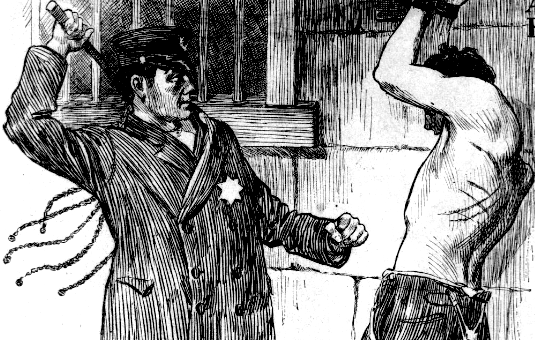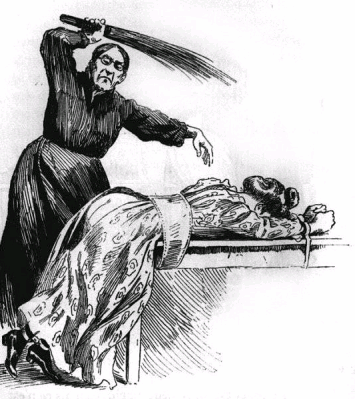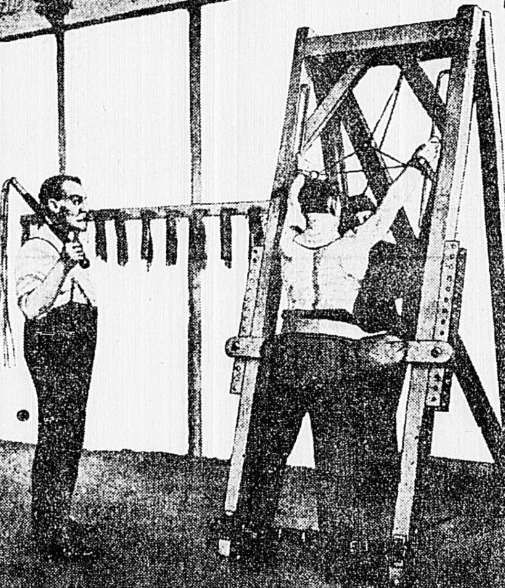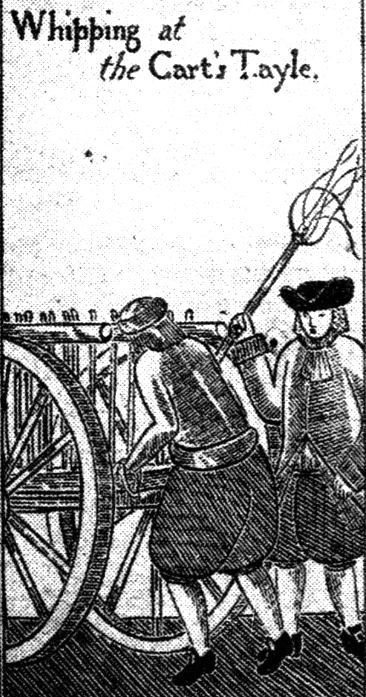
Corporal punishment, by definition, is some form of physical punishment for a wrongdoing. Parents who spank children, teachers who smack children’s hands with rulers, soldiers who are whipped with the cat-o-nines, and prisoners who are flogged are all forms of corporal punishment.

1. The Blue Man and Boot Nuns
Corporal punishment was once very popular in children schools. Religion was almost always tied into the schools, and it was believed that sin and misbehavior could be beaten out of a child.
The “blue man” was feared by the school children of Germany during the 19th century. This man, whose identity was left unknown to the children, would go from school to school dressed in a blue cloak and wearing a mask. His duty was to flog children who misbehaved in class. This flogging was not set aside for only the worst children in school. In fact, in a book published in 1907, it was stated that “it was a very rare thing for a boy to graduate from the gymnasium and be able to say upon leaving he had never been under the care of the ‘blue man.’”
Augsburg had its own terrifying creature called the “boot nun.” The nuns in this city wore special small boots in the winter. When one of the boys in their schools would misbehave, the six- to ten-year-old would be forced to get on his hands and knees, and place his head into the opening of the iron stove. While in this position, the nun would pull down his pants and beat him with a rod. This position kept the boy’s head and face safe from the rod, but the rest of his body was fair game.
2. Barrel Punishment
In the late 19th century, the Waukesha Industrial School for boys in Wisconsin had its own sort of corporal punishment. Boys who were in need of punishment were made to wear a wooden barrel.
According to a newspaper article published in 1897, one end of a molasses barrel would be removed and in the other end a large hole was cut into it. The boy in trouble was then made to strip to his waist and wear the barrel. The weight and coarseness of the wood on his bare shoulders would cause him excruciating pain as he was made to walk the field for an hour.
After wearing the barrel, the boy was allowed to take it off, but then he had to stand on top of the barrel for up to another ten hours. During this time, he was only allowed to have one slice of bread and one glass of water. No one was allowed to give him any other food during this time and, depending on what the boy did or the mood of the teacher, the boy could be subjected to the same punishment the next day.

3. Barrel Rack
A penitentiary in Michigan used a small, wooden beer barrel in quite a different way, according to an article published in 1912. The barrel was attached to a nine-foot long ladder and a prisoner’s torso would be strapped to the barrel while his hands and feet were tied to the ladder. While in this stretched position, the prisoner’s head was covered with a sheet to prevent him from seeing who would be punishing him.
A special paddle was made for paddling the stretched out prisoner. It was made of heavy shoe leather, perforated with tiny holes, and fastened to a wooden handle. This paddle was laid on the prisoner with full force and it was said that when the leather was pulled off the prisoner’s flesh at the end of each strike, the flesh was pulled from the small holes in the leather which intensified the pain.
After the prisoner suffered through the paddling, a sheet soaked in salt water was placed on his body to further shock his body with pain.
4. Flogging to Stimulate the Mind
Samuel Parr, an English schoolmaster and minister, served as headmaster at Norwich Grammar School from 1778 until 1785. During his time at Norwich, he openly believed that children should be flogged, not only for disciplinary matters but also to stimulate the learning process. In other words, if a student was considered mediocre, he would be flogged to improve his performance.
One of the men who worked at the school once remarked that a certain student showed talent. Samuel Parr took note of the student and responded, “Then let the flogging begin tomorrow morning.”
In 1904, there were still teachers who believed that flogging somehow made students smarter. One parent wrote: “Flogging, a relic of barbarism, is still rife in the country schools, cases being on record of boys receiving a severe thrashing for not knowing the elements of Euclid.”
Seventeen years later, in 1921, a parent wrote to the newspaper saying, “My little girl of seven has been caned repeatedly for looking off her book for a moment, and the other day she was caned for not knowing the date.”

5. Birched for Bad Language
In Tasmania, 1898, obscene language was the cause of one young man’s imprisonment and caning. According to the story, Higgins “used obscene language in Barrack Square.” He was overheard, detained, and sentenced to seven days of imprisonment. During this time, he would be birched for his foul mouth.
While the article about this event failed to state whether he was taken to a public whipping post, the reporter did state that the young man “took badly” to the five deep cuts made by the caning.
More recently, in 1964, 23 boys were caned in front of 650 students, both boys and girls, in New South Wales. Reporters stated that they did not question the right of the headmaster to cane the boys, but that by beating the boys in public was a “serious breach of discipline.”
6. Caning as a Parental Duty
While parental corporal punishment was, at one time, a popular punishment, there were times when parents were ordered to beat their children. In the case of a young Kingaroy arson in 1932, whose exact crime was not published but obviously did not amount to the burning of a building or the loss of life, the judge allowed the boy to return home with his father on the condition that the boy was caned. According to one report, the father was to use a bamboo cane on the boy in the presence of a sergeant of the local police station.
It was important that parental corporal punishment had an impartial witness because parents were known to go overboard. In 1897, New South Wales, a boy and his father were brought to the local police court. The father had punished his son mercilessly with a cart whip. According to the police inspector, the boy’s back looked worse than any beaten prisoner he had seen.
The father was given a small fine and the boy was handed over to his divorced mother.
7. Straight Jacket and the Strap
Girls were not spared the rod, or in this case, the strap. In 1902, the Girls’ Industrial Home in Ohio was under investigation for abuse after one of the girls died under suspicious circumstances.
According to one of the witnesses, she had heard the matron tell the student, Nora Ferris, that she had to put on the straightjacket. After the jacket was on, the girl was strapped to a cell window, and whipped with the strap. She died while still tied in the standing position.
Another girl, aged sixteen, was given fifteen strokes of the strap. Yet another girl was given twenty-five strokes for stealing a pencil.
When questioned about the abuse at the school, one of the school’s teachers said “if corporal punishment here at the home was prohibited, I would not remain here.” Another teacher at the school stated that it was her duty to make the “punishments as severe as she was able.”
8. The Texas Bat
The hated “bat” was used on prisoners in Texas until it was banned in 1941. The bat was a thick, leather whip that was two feet long and four inches wide. Prisoners were generally forced to drop their pants and put their hands to the wall. They were then whipped with the bat across their backs and buttocks up to, and sometimes exceeding, 39 strokes.
One of the earliest accounts of the bat comes from a convict in 1879. After John Wesley Hardin attempted to escape the prison, he was stripped, and tied face down onto the floor. He was given 39 strokes of the bat.
With repeated use, the bat became stained with blood and, eventually, it took on new names, such as “Red Heifer” and “Red Bet.” However, those in charge of the prisons believed that beating prisoners was more humane than solitary confinement and holding a prisoner in a dark cell.

9. The Whipping Act
If we go further back in time to England, 1530, we find that the King Henry VIII passed something called the Whipping Act. This Act allowed for homeless beggars, poachers, thieves, blasphemers, and the insane to be gathered up and taken to the town square where they were stripped naked and tied to the end of a cart. These people were then whipped until bloody.
Public whippings were finally abolished in England in 1817.

